We continue today with more analysis of my crazy move, 4. g4!? in the Caro-Kann. (See Grob It While You Kann for the beginning of the series.) To refresh your memory, the line begins 1. e4 c6 2. d4 d5 3. e5 Bf5 4. g4!? I don’t know if this variation has a name. Michael Goeller calls 4. h4 the “Caveman Variation.” I guess I’ll call 4. g4 the “Homo Erectus Variation,” on the grounds that Homo erectus is even more primitive than a caveman.
Last time I wrote about the line 4. … Bg6. This time I’ll discuss 4. … Be4, which seems to be Black’s most common response in practice. I’ve faced it in tournaments nine times, and I have a ridiculous record of +8 -0 =1 (a winning percentage of 94%!) against it.
The idea of this move is first to induce White to play 5. f3, and then to retreat the bishop with 5. … Bg6. The point of this two-step is that with the square f3 now occupied, White can no longer play Ng1-f3-e5, and so the threat of 6. e6 loses some of its oomph.
So far I have never played 6. e6 here. Instead, I think it’s best to switch gears and pursue Black’s bishop with 6. h4. I queried this move in the 4. … Bg6 line, but here I think it works better because the pawn on g4 is defended by the pawn on f3. As they say, “when life gives you lemons, make lemonade.”
Black will almost always reply 6. … h5, and justifiably so. 6. … h6 is a real quiche-eating move that allows White exactly what he wants: 7. h5 Bh7 8. e6 Qd6 9. ef+ Kxf7 10. f4 Nf6 11. Nf3! White has kept Black from castling, and his knight is coming to e5, and he couldn’t be happier.
After 6. … h5, I’m still not a fan of 7. e6?! because 7. … Qd6 puts the finger on some really weak dark squares on White’s kingside. So I prefer to actually play a developing move (finally!) with 7. Ne2. (I used to play 7. Nh3 for amusement, but there is no real difference because White always plays 8. Nf4 on the next move.) Black’s most common answer is 7. … hg. In my only game with 7. … e6 8. Nf4 Be7 9. Nxg6 fg (Mackenzie-Cunningham, 1987) I should have played 10. Qd3! and, no matter how Black replies, White will achieve his goal of preventing him from castling queenside. Instead I played 10. g5?! and eventually drew, the only time I have been nicked for a draw in this variation.
After 7. … hg, White plays 8. Nf4, of course. Now we come to a fork in the road.
(A) 8. … gf? This extra-greedy move has only been played once against me, in the game Mackenzie–Mallett, 2003. After 9. Nxg6 f2+ (presumably this was Black’s idea — he wanted to lure my king out in the open) 10. Kxf2 fg, we have an amusing position where after 10 moves for both sides, the only developed piece is White’s king! After 11. Qg4 White is a little better, but Black made things a lot worse by playing 11. … Qb6?? 12. Qc8+. He explained after the game that he realized too late that after 12. … Kf7 I could play 13. e6+ and win his bishop. So instead he played 12. … Qd8, and after 13. Qxb7 I won easily.
(B) 8. … e6. Curiously, I have never faced this in a tournament game, although I’ve seen it quite a few times in speed chess. For a while I thought it was Black’s best chance at “refuting” the Homo Erectus Variation, in the sense that White had to settle for a draw by repetition. However, I no longer think so. White plays 9. Nxg6 hg and now, instead of 10. Qd3, which only draws (10. Qd3 Rxh4 11. Qxg6+ Kd7 12. Bg5 Qa5+ 13. Bd2 Qd8 14. Bg5 =), White calmly plays 10. fg Rxh4 (diagram) and now…
11. Rg1! This unbelievable move is 100 percent a computer discovery. I never would have thought of it in a million years! It seems passive, and it looks as if Black is rampaging on the h-file, but after 11. … Rh2 12. Qd3! Qh4+ 13. Kd1 my king is in no trouble at all! Go ahead and play 13. … Qf2, White says. Make my day! Or even better, play 13. … Ne7 14. Nd2 Qf2? 15. Nf3, and White either wins the exchange or traps the Black queen.
Anyway, the idea is that Black’s extra pawn on g6 is worthless. White will still have time to play Qd1-d3-g6+ and catch Black’s king in the center, unless Black plays … Ne7. But if Black does that, his kingside pieces are just suffering, the bishop and knight both tied down and unable to move.
(C) 8. … Bh7 is a move I have faced in two tournament games. At first I thought it was a real quiche-eating move, but I gained some more respect for it after the game Mackenzie – Mallett 2004: 9. fg e6 10. Nc3?! (This is too slow; Fritz says White has to play 10. g5, to threaten g6 and thereby distract Black from his counterplay) 10. … c5! 11. dc Nc6 12. Bb5 Bxc5 13. Nh5 Kf8 14. Bxc6 bc 15. Bg5? …
OK, here I’m going to stop and tell you an interesting story. Jeff Mallett had lost to me in subvariation (A) the previous year in the Santa Cruz Cup, as I mentioned earlier. In the following year’s Santa Cruz Cup, knowing that we were going to face each other again (because it was a round robin), he went to his computer and prepared this line. So up to this point, we were completely in Jeff’s home preparation! But now I played 15. Bg5, a move so bad that it hadn’t turned up in Jeff’s computer analysis. But it’s bad in a very funny way. If Black finds the star move, 15. … Qb8!, forking the b- and e-pawns, it’s completely lights out. The move White played in the game, 16. Qf3, won’t work because of 16. … Qxe5+. But if Black doesn’t find that move, then White’s position is fine. I think you’ll agree with me that 15. … Qb8 is a somewhat hard move for a human to see. It’s completely trivial for a computer, of course.
A great lesson in the dangers of trusting computer analysis! Its evaluation of a position may be based on moves that you won’t be able to come up with.
So Jeff missed his opportunity and played 15. … Qb6? instead, allowing 16. Qf3! White is still sacrificing a pawn, but whichever pawn Black takes, White gets great compensation for it. He chose to play 16. … Bd4 17. Rf1 Qc7 18. O-O-O Bxe5. Black has moved his queen twice, his king bishop three times, and his queen bishop four times. By contrast, each of White’s pieces has moved only once, except for the knight, which has moved three times to a very powerful square, h5. Is it any wonder that White has a big advantage? I won in 11 more moves.
Nevertheless, this line is now offiicially certified as UNRELIABLE in Dana’s Secret Opening Files. If I face subvariation (C) again, I will try Fritz’s top choice, 9. e6. Here is an example, a game Fekih-Horchler, e-mail 2004 (one of the few games with the Homo Erectus Variation in ChessBase): 9. … gf 10. ef+ Kxf7 11. h5 f2+ 12. Kxf2 Be4 13. Ng6 Rh7 14. Ne5+ Ke8 (diagram)
15. Nc3!! Bxh1 16. Bd3 (Threat: Bg6 mate! This diagonal is always Black’s Achilles heel in the Homo Erectus Variation.) 16. … Be4 17. Nxe4 Nd7 18. Nc5! and White went on to win in beautiful style.
(D) Now we come to what has to be considered the main line, 8. … Bf5. I have faced this in three games, and always played 9. fg. Actually, 9. e6!? is very interesting here, too, and definitely worth a try. Here’s some computer analysis. (Warning! User beware!) If 9. … fe 10. fg Be4 11. Rh3 Qd6 12. Nc3 +/-, says Fritz. If 9. … gf 10. ef+ Kxf7 11. Qxf3 Be4 12. Qg3! (again threatening the mate on g6 if Black’s bishop leaves the b1-h7 diagonal) Qd6 13. Re2 +/=, says Fritz. Finally, if 9. … Bxe6, which looks best to the computer, then 10. Nxe6 fe 11. Qd3 or 11. f4 (I’m not sure which is better) and Black has an extra pawn or two, but he’s hella tied up on the Kingside. I don’t think many Black players will want to play this.
Sorry to invoke all this computer analysis, but I never even thought about 9. e6 before today.
Okay, back to the main line after 8. … Bf5 9. fg. Of course, Black plays 9. … Be4 and we continue 10. Rh3 e6 11. h5 Be7 12. Be3. In Mackenzie–Filipovich 2007, Black threw in the check 12. … Bh4+ 13. Kd2 and then regretted it, because his bishop is kind of out on a limb on h4. After 13. … Bg5 14. Nc3 Bh7 15. Qf3 I was very happy with my position, and I eventually won after a few adventures.
Finally, Mackenzie–Garcia, Harvard Open 1986, has historic significance because it was my first tournament game ever with the Homo Erectus Variation, and it still illustrates the themes very nicely. Garcia played 12. … Qb6 13. Nd2 Nd7. (The computer says that 13. … Qxb2 is better, but I’m not too worried about the b-pawn.) 14. Nxe4 de 15. Bg2 Rd8 (A big turning point. Is Black’s king safer in the center or on the queenside? Black decides to keep him in the center.) 16. Qxe2 Qxb2 17. Rd1 Qxa2 18. Bxe4 Qa5+? (This natural move loses! Of course Black wants to rescue the queen, but he fails to realize that on a2 the queen was actually doing something important — it was defending the e6 pawn. The best move for Black would be 18. … Nb6, with the idea of … Nd5 or … Nc4 at some point. But the unsettled position of Black’s queen out in limbo, and Black’s king still in the center of the board, means that White should at least have compensation for his pawn.) 19. Bd2! Qb6 (diagram)
White to play and win.
Once again the weak white squares come back to haunt Black. I played 20. Nxe6! fe 21. Bg6+ Kf8 22. Rf3+ Ngf6 23. ef Bb4 (desperation now, as Black realizes he can’t play 23. … gf because 24. Qxe6 forces mate) 24. Qxe6 Bxd2+ 25. Rxd2 Ne5 26. fg+ (Oops, I missed a mate in two with 26. Qe7+. Sorry.) 26. … Kxg7 27. Qxe5+ Kg8 28. Qe6+ Kg7 29. Rf7+ Kh6 30. g5+ Kxg5 31. Qe3+ Kg4 32. Rg2+ Kh4 33. Qg3 mate.
Well, if anyone out there is reading this, that’s quite a lot for you to chew on! Next time we’ll look at Black’s third option on move 4, retreating the bishop to d7.
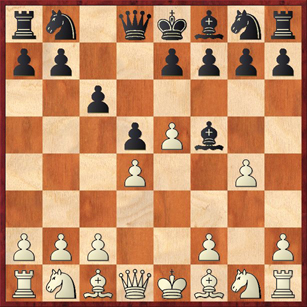
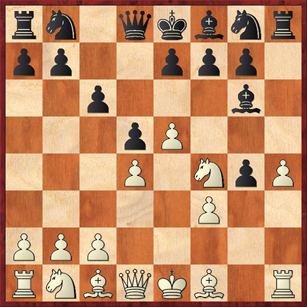
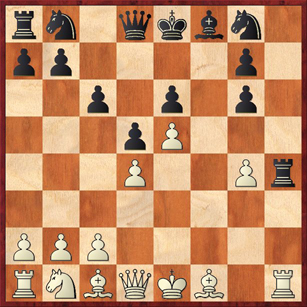
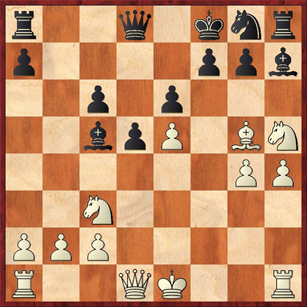
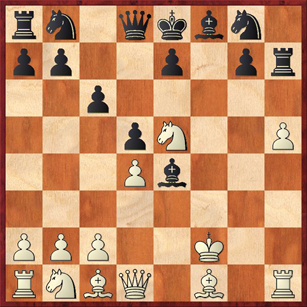
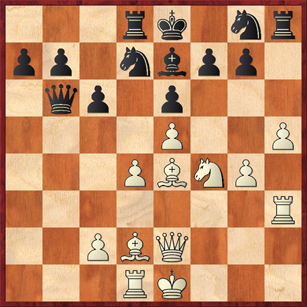



{ 7 comments… read them below or add one }
All very inspiring — and very nice games. But Bd7 is definitely the real test. I find it annoying even in the Caveman after 4.h4 h6!? 5.g4 Bd7! when Black basically turns the game into an Advance French where White’s wing pushes are not the norm. So I’m curious to see what you have on Bd7. This also points up one potential advantage of waiting for Black to commit with e6 before hitting him with g4 — so 4.Nc3 e6 5.g4 etc.
I’ll have to link to this…
Hi Michael,
I’m going to be interested to see my next post, too! The reason is that I don’t actually have a good answer to Bd7. My record against it is much worse than the other two lines. I think that 4. … Bd7 is likely to be played by more sophisticated players (e.g., masters), who can correctly assess that it’s not worth the trouble to keep their bishop outside the pawn chain.
For more information, you’ll have to wait for my next post!
These posts are really educational for me, too, because it’s a chance to organize my thoughts about this variation. Although I’ve played all these games, this is the first time I’ve gone over them systematically and tried to figure out what worked and what didn’t.
You think you can add a pgn file or pdf file for downloads.
Believe it or not I am going through the same exercise (systematically going over opening repertoire) and it is benefiting me tremendously. It is like a eureka moment. Suddenly,opening moves or setups seem to make sense especially the move-order tricks.
I just recently discovered and am beginning to unearth gems on Michael’s blogsite as well. Good stuff from both of you. I am amazed by the quality of the writing and the chess knowledge found on both blogs. Kudos!
This is a great article and I enjoyed reading it. I look forward to reading your next post on this!
I am Zach and I am a 12 year old chess player. My current rating is 1233(big, horiffied gasp) and I really think I benefited from your analysis on the Homo erectus Variation. Do you have any other opening ideas on other openings? Also, since I am not a extremely good player and cannot judge my own writing as well as a A or B class player, would you mind taking a look at my opening ideas on my blog?(www.chessforkids.wordpress.com) I would like to see your ideas and compare them to my coaches analysis.(I am taking lessons with a GM and I am psyched at my good fortune! 🙂 ) I think it would really help me since my ideas are for pre-tournament players to players rated 1000 and I would like to give them the right idea right off the bat. I would greatly appreciate it If you could comment it with your ideas and stuff like that. Thanks.
Nice write up…usually I never reply to these thing but this time I will,Thanks for the great info.
great article. no other words needed 🙂
{ 1 trackback }